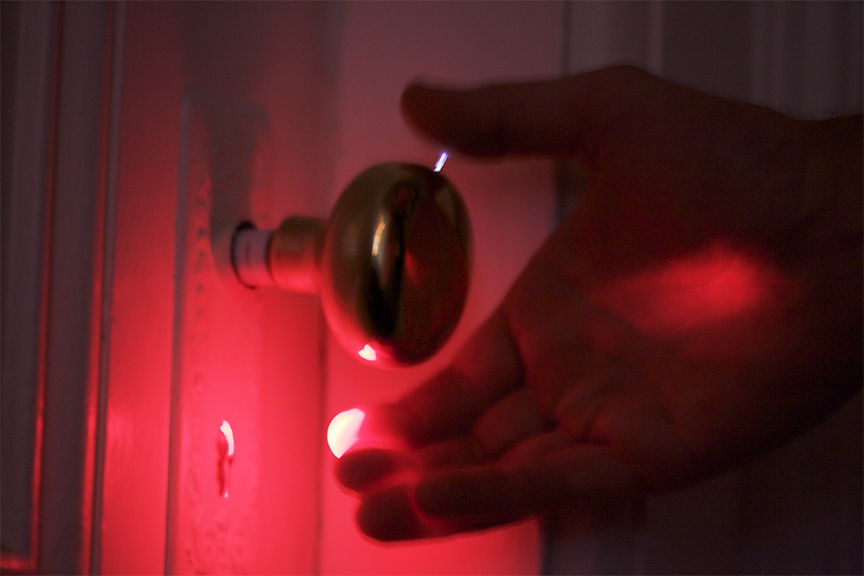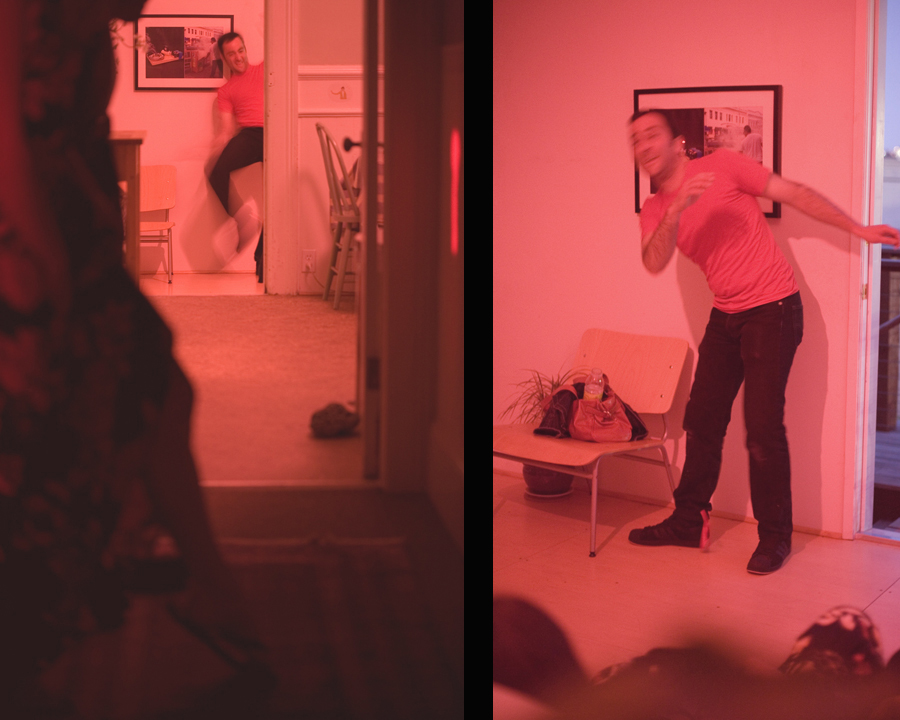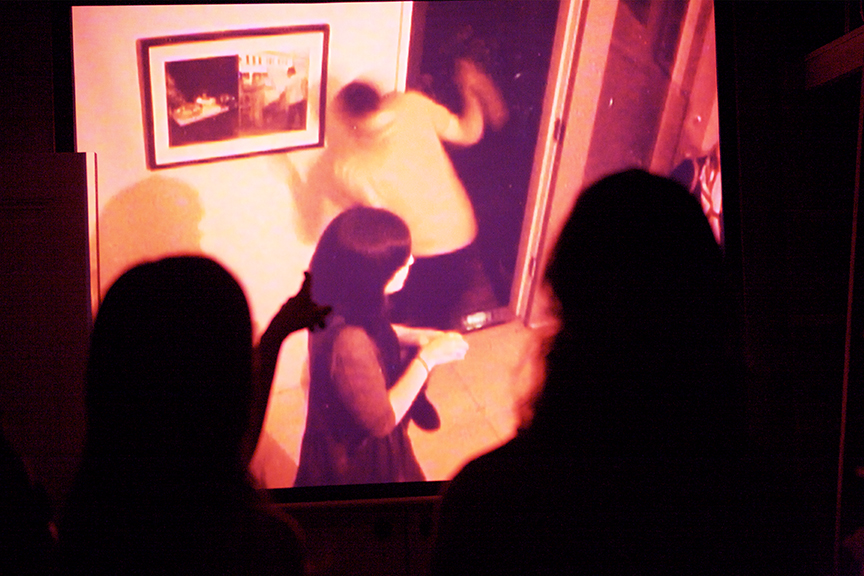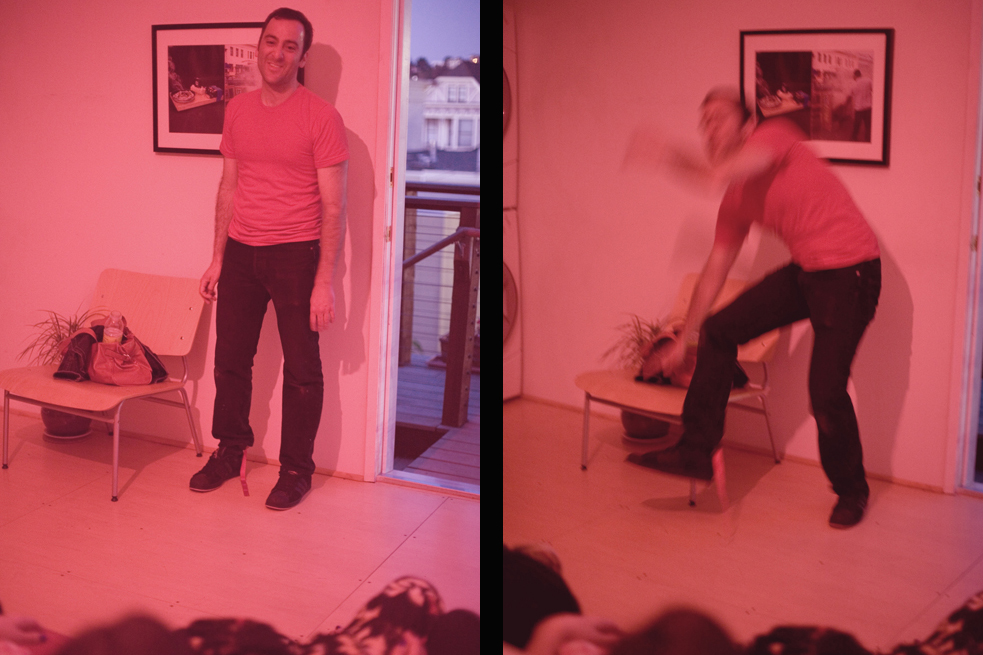Muster, San Francisco, CA, May, 2009
As with the other pieces in the Yoga Teacher Series, in this project I am examining one of the five senses. Muster Retrodiction revolves around our sense of touch. Several months ago I began to study how to predict the future. My initial research led me to an examination of herding. If a person sets up a particular set of parameters in order to move a body of animals in desired fashion, they are in a sense predicting the way that the animals will react given that particular stimuli. Stimuli can take many different forms such as voice commands, dogs barking, or electric fences. The first recorded usage of the word “herd†refers to a person who controls or musters animals. Soon after “herd†also began to describe the group of animals that is being controlled. Originally, English speakers made no distinction between the group being controlled and the person that controls them.
Building on this idea in Muster Retrodiction I seek to impress three things upon the viewer: 1) They are being moved through the gallery in a particular way. 2) It is I (the artist) that is predicting and controlling their movements. 3) That as the viewers move, their movements have a direct physical effect upon me, the artist that is controlling them.
The gallery is on the second floor and the light in the stairwell has been replaced with a dim red bulb. When viewers first enter the gallery they will usually walk into the front room that is at the top of the stairs. The lights are off in this front room and there is a video being projected that is a live feed from the back room of the house. The shot is of me standing and talking to people in a room that is also lit with a dim red light. To get to the back room one must walk down a long narrow hallway and then through the kitchen (also lit with a dim red bulb). There are three doors in the hall. Each is locked and there is a red light illuminating from its old-fashioned, skeleton key hole. The light casts a large silhouette of the keyhole on to the opposite wall. As viewers observe the lights they become compelled to touch the doorknobs. As soon as they touch the doorknob they receive a mild electrical shock. Which, like an animals electrical fence, propels them away from the door and prompts their movement down the hall. As they walk down the hall their footsteps trigger switches hidden underneath the rug. These switches then trigger an electric shocking device that is attached to my ankle. In the back room I am standing and talking to people about the show and the photographs that I have displayed. As I talk with gallery goers, I periodically receive shocks triggered by people moving about in the hallway. When I get a shock, my leg uncontrollably jerks out to side as if a doctor was whacking my knee with a gigantic electrified rubber mallet and I let out a yelp. After an audience member is herded and then understands what is happening in the piece, the group or “herd†mentality kicks in. The “herded†now go and try to find the hidden triggers to purposely shock me. Other audience members watch the video in the front room and encourage those in the hallway to time the shocks so I dance about like a marionette while I talk to people.
I rarely assume a traditional performance art posture, in which an artist takes on a silent or austere role. Instead I talk and interact with people. If audience members are confused about something, I do my best to answer their questions in a honest and straightforward fashion. There are three pieces of photographic documentation (shown above) displayed in the backroom with me. As people come and go in the back room I explain the performances that created the photographs. These photographs highlight a series of performances that I have been constructing in which I assume a very passive role and at the same time posture viewers into challenging positions without them realizing it. These pieces address our perceptions of power by examining our five senses. Muster Retrodiction is the fourth piece in that series of interventions and addresses our sense of touch.
The first piece, Sniff, dealt with our sense of smell and was done in San Francisco. I made a device that creates an enormous amount of sage smoke that is placed underneath newspaper dispensers. From far away it appears as if someone has torched the dispenser, but up close viewers have a much different experience. When a viewer opens the front door to the dispenser they become bathed in a huge wash of sage smoke. Sage has been used for thousands of years to purify spaces of negative influences and energies.
The second project, Egress, dealt with our sense of hearing and was done in Portland, OR in a gallery that Patrick Rock runs out of his home called ROCKSBOX. A pit-bull was leashed to my torso while I laid on the ground, bound with zip-ties for five hours. The door to the room was locked from both the inside and the outside. By using a small remote control I was able to activate an electric release in the door that permitted viewers to enter and exit the space when I saw them in the doors window. The only way in or out of the room was through my permission. Down the hall there was a second room that was also locked from both the inside and the outside. I programmed a timer to activate an electric release in the door every two minutes that allowed viewers to enter and exit the space. Inside the empty room an audio track looped that outlined a teenage boy’s experience forcing his dog to suck his penis. The only way in or out of the room was when the timer that I programmed permitted egress. When viewers first came into the room in which I was lying on the ground they could stay as long as they wanted to (usually the length of time was dictated by the dog) and could ask me whatever they wanted. When they were ready to leave each tried to open the door and subsequently realized that they were locked in and needed me to buzz them out. Before they left I reminded them that there was a second room down the hall to experience. Typically whatever assumptions viewers made about the piece given their interaction with me in the first room was destroyed when they were forced to listen to the audio track in the second room.
The third intervention, 9/10, dealt with our sense of sight and was done New York City. A cabinet was constructed and left on the sidewalk. I was hidden inside and did not reveal myself until someone brought me from a public space to a private space. Throughout the experience pictures and text messages were being sent to a blog: lucasmurgida.blogspot.com.
In each of these pieces I assumed what appeared to be very passive role in attempt to disarm viewers as they freely chose to be herded into alarming and challenging situations. Next up: Our sense of taste @ The Charlie James Gallery, LA, CA, July of 2009. http://www.cjamesgallery.com. A special thanks to Chris Sollars and Leland Scantlebury for all of their hard work and help making this piece happen and for documenting my life in such a considerate way. Thanks for reading.




